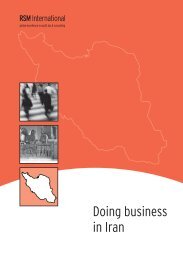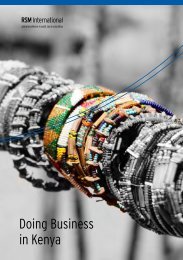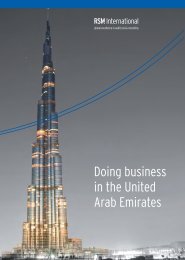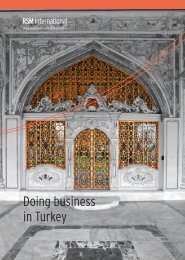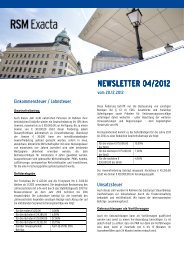Doing Business in India - RSM Austria
Doing Business in India - RSM Austria
Doing Business in India - RSM Austria
Create successful ePaper yourself
Turn your PDF publications into a flip-book with our unique Google optimized e-Paper software.
3.0 EXTERNAL COMMERCIAL BORROWINGS (ECB)<br />
External Commercial Borrow<strong>in</strong>gs (ECB) refer to commercial loans <strong>in</strong> the form of<br />
bank loans, buyers’ credit, suppliers’ credit, securitised <strong>in</strong>struments such as float<strong>in</strong>g<br />
rate notes and fixed rate bonds availed from non-resident lenders with m<strong>in</strong>imum<br />
average maturity of 3 years.<br />
ECB can be accessed under two routes, viz., (i) Automatic Route and (ii) Approval<br />
Route.<br />
3.1 Automatic Route<br />
3.1.1 Eligible Borrowers<br />
i. Corporates (registered under the Companies Act except f<strong>in</strong>ancial<br />
<strong>in</strong>termediaries such as banks, f<strong>in</strong>ancial <strong>in</strong>stitutions, hous<strong>in</strong>g f<strong>in</strong>ance<br />
companies and NBFCs) are eligible to raise ECB.<br />
ii.<br />
Units <strong>in</strong> Special Economic Zones (SEZ) are allowed to raise ECB for their<br />
own requirement. However, they cannot transfer or on-lend ECB funds to<br />
sister concerns or any unit <strong>in</strong> the Domestic Tariff Area.<br />
Individuals, Trusts and Non-Profit mak<strong>in</strong>g Organizations are not eligible to raise<br />
ECB.<br />
3.1.2 Recognized lenders<br />
ECB can raise from <strong>in</strong>ternationally recognized sources such as<br />
i. <strong>in</strong>ternational banks;<br />
ii. <strong>in</strong>ternational capital markets;<br />
iii. multilateral f<strong>in</strong>ancial <strong>in</strong>stitutions (such as IFC, ADB, CDC, etc.);<br />
iv. export credit agencies;<br />
v. suppliers of equipment;<br />
vi. foreign collaborators and;<br />
vii. foreign equity holders (other than erstwhile OCBs).<br />
“foreign equity holder” to be eligible as “recognized lender” under the automatic<br />
route would require m<strong>in</strong>imum hold<strong>in</strong>g of equity <strong>in</strong> the borrower company as set out<br />
below:<br />
i. For ECB up to US$ 5 million - m<strong>in</strong>imum equity of 25 % held directly by the<br />
lender,<br />
ii. For ECB more than US$ 5 million - m<strong>in</strong>imum equity of 25 % held directly by<br />
the lender and debt-equity ratio not exceed<strong>in</strong>g 4:1 (i.e. the proposed ECB<br />
not exceed<strong>in</strong>g four times the direct foreign equity hold<strong>in</strong>g).<br />
3.1.3 ECB Amount and Maturity<br />
i. The maximum amount of ECB which can be raised by a corporate is US$<br />
500 million or equivalent dur<strong>in</strong>g a f<strong>in</strong>ancial year.<br />
DOING BUSINESS IN INDIA 73



